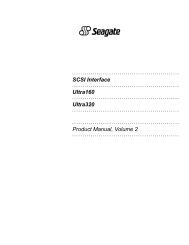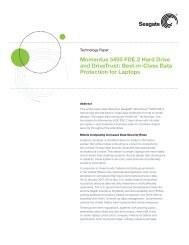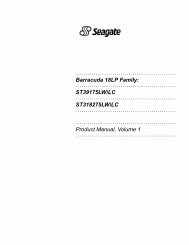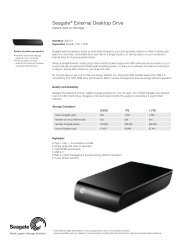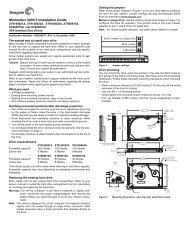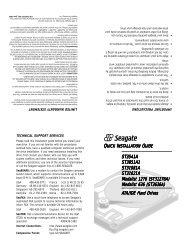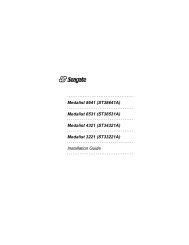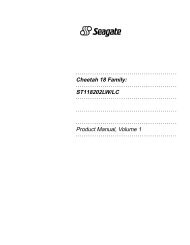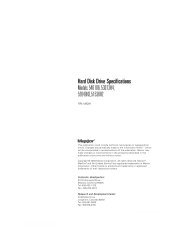Quickview 300 Product Manual PATA - Seagate
Quickview 300 Product Manual PATA - Seagate
Quickview 300 Product Manual PATA - Seagate
You also want an ePaper? Increase the reach of your titles
YUMPU automatically turns print PDFs into web optimized ePapers that Google loves.
Appendix A<br />
BREAKING THE 137 GIGABYTE STORAGE<br />
BARRIER<br />
This appendix provides information about the 137GB storage barrier. It<br />
discusses the history, cause and the solution to overcome this barrier.<br />
A.1 Breaking the 137 Gigabyte Storage Barrier<br />
Capacity barriers have been a fact of the personal computer world since<br />
its beginnings in the early 1980’s. At least 10 different capacity barriers<br />
have occurred in the storage industry over the last 15 years. The most<br />
notable barriers seen previously have been at 528 megabytes and then at<br />
8.4 gigabytes.<br />
The ANSI NCITS T13 Technical Committee (also known as the ANSI ATA<br />
committee) has broken this barrier by incorporating a proposal from<br />
Maxtor into the ATA/ATAPI-6 draft standard that defines a method for<br />
48-bit addressing on a single drive, giving more than 144 petabytes<br />
(144,000 gigabytes) of storage.<br />
In addition, the proposal from Maxtor that was incorporated into ATA/<br />
ATAPI-6 defines a method for extending the maximum amount of data<br />
that can be transferred per command for ATA devices from 256 sectors<br />
(about 131 kilobytes) to 65,536 sectors (about 33 megabytes). This new<br />
method is particularly useful for applications that use extremely large<br />
files, such as those for A/V or multimedia.<br />
The following sections will describe issues surrounding the 137-gigabyte<br />
barrier and the solution for breaking it.<br />
A.1.1<br />
History<br />
Many of the “barriers” in the past resulted from BIOS and operating<br />
system issues caused by failure to anticipate the remarkable increases in<br />
device storage capacity by the people who designed hard disk structures,<br />
access routines, and operating systems many years ago. They thought,<br />
“Who will ever have xxx much storage?” In some cases, the barriers were<br />
caused by hardware or software bugs not found until hard disks had<br />
grown in size beyond a certain point where the bugs would occur.<br />
Past barriers often frustrated people trying to add a new hard disk to an<br />
older system when they discovered that not all of the designed capacity<br />
<strong>Quickview</strong> <strong>300</strong> 80/100/120/160/200/250/<strong>300</strong>GB <strong>PATA</strong> A-1



